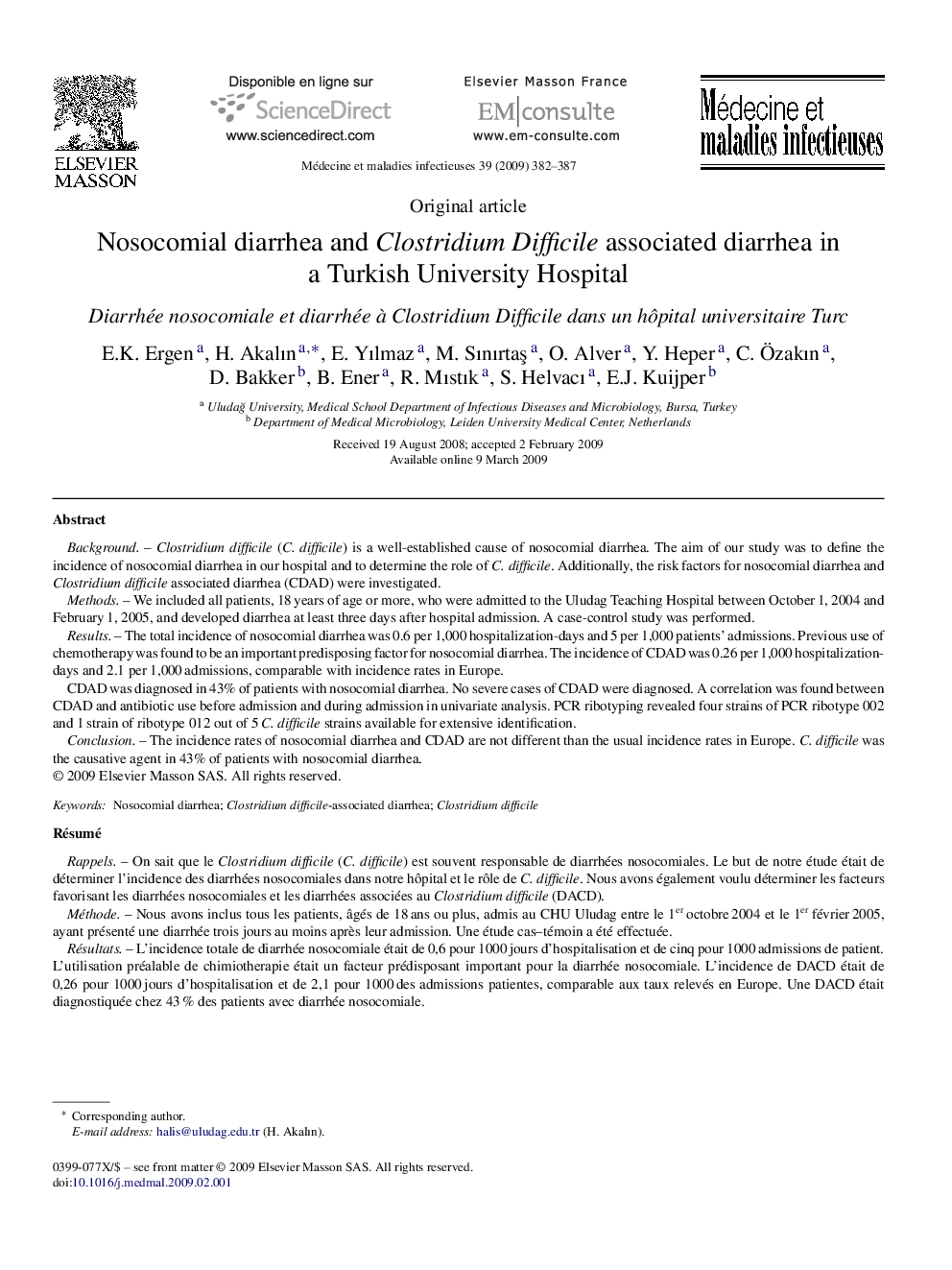| کد مقاله | کد نشریه | سال انتشار | مقاله انگلیسی | نسخه تمام متن |
|---|---|---|---|---|
| 3413707 | 1224310 | 2009 | 6 صفحه PDF | دانلود رایگان |

BackgroundClostridium difficile (C. difficile) is a well-established cause of nosocomial diarrhea. The aim of our study was to define the incidence of nosocomial diarrhea in our hospital and to determine the role of C. difficile. Additionally, the risk factors for nosocomial diarrhea and Clostridium difficile associated diarrhea (CDAD) were investigated.MethodsWe included all patients, 18 years of age or more, who were admitted to the Uludag Teaching Hospital between October 1, 2004 and February 1, 2005, and developed diarrhea at least three days after hospital admission. A case-control study was performed.ResultsThe total incidence of nosocomial diarrhea was 0.6 per 1,000 hospitalization-days and 5 per 1,000 patients’ admissions. Previous use of chemotherapy was found to be an important predisposing factor for nosocomial diarrhea. The incidence of CDAD was 0.26 per 1,000 hospitalization-days and 2.1 per 1,000 admissions, comparable with incidence rates in Europe.CDAD was diagnosed in 43% of patients with nosocomial diarrhea. No severe cases of CDAD were diagnosed. A correlation was found between CDAD and antibiotic use before admission and during admission in univariate analysis. PCR ribotyping revealed four strains of PCR ribotype 002 and 1 strain of ribotype 012 out of 5 C. difficile strains available for extensive identification.ConclusionThe incidence rates of nosocomial diarrhea and CDAD are not different than the usual incidence rates in Europe. C. difficile was the causative agent in 43% of patients with nosocomial diarrhea.
RésuméRappelsOn sait que le Clostridium difficile (C. difficile) est souvent responsable de diarrhées nosocomiales. Le but de notre étude était de déterminer l’incidence des diarrhées nosocomiales dans notre hôpital et le rôle de C. difficile. Nous avons également voulu déterminer les facteurs favorisant les diarrhées nosocomiales et les diarrhées associées au Clostridium difficile (DACD).MéthodeNous avons inclus tous les patients, âgés de 18 ans ou plus, admis au CHU Uludag entre le 1er octobre 2004 et le 1er février 2005, ayant présenté une diarrhée trois jours au moins après leur admission. Une étude cas–témoin a été effectuée.RésultatsL’incidence totale de diarrhée nosocomiale était de 0,6 pour 1000 jours d’hospitalisation et de cinq pour 1000 admissions de patient. L’utilisation préalable de chimiotherapie était un facteur prédisposant important pour la diarrhée nosocomiale. L’incidence de DACD était de 0,26 pour 1000 jours d’hospitalisation et de 2,1 pour 1000 des admissions patientes, comparable aux taux relevés en Europe. Une DACD était diagnostiquée chez 43 % des patients avec diarrhée nosocomiale.Aucun cas grave de DACD n’était rapporté. L’analyse univariée relevait une corrélation entre une DACD et l’utilisation d’antibiotiques avant et après l’admission à l’hôpital. Le ribotypage par PCR identifiait quatre souches de PCR ribotype 002 et une souche de ribotype 012 sur cinq souches de C. difficile disponibles pour une identification ultérieure.ConclusionLes taux d’incidence de diarrhée nosocomiale et de DACD n’étaient pas différents des taux habituellement relevés en Europe. Le C. difficile était l’agent responsable chez 43 % des patients avec diarrhée nosocomiale.
Journal: Médecine et Maladies Infectieuses - Volume 39, Issue 6, June 2009, Pages 382–387